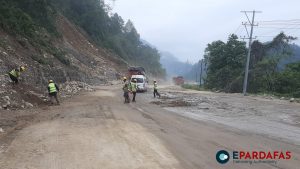
Women journalist-friendly policies emphasised

The legislations, policies and guidelines related to journalism and mass communication should incorporate the issues of women journalists. For women to not have fear of sharing their opinions and existing in work and public spaces, the change must start with free, gender-sensitive media.
This point was emphasised by media experts and participants of the ‘Workshop on Gender-Sensitive Leadership and Safety of Journalists’, organised by Federation of Nepali Journalists (FNJ) here today in the context of the 16 days of activism against gender-based violence.
They have stressed on putting in place policy measures for ending all forms of violence against women journalists and their implementation.
FNJ president Bipul Pokharel said the media houses should formulate their internal policy, code of conduct and editorial policy for ending the violence against women at the work place and within the media house.
He suggested including lessons on ending violence against women and GBV in the school level curriculum for a meaningful intervention to eliminating GBV.
President of Sancharika Samuha, the Forum of Women Journalists and Communicators, Bimala Tumkhewa said that although women journalists have been facing gender-based violence in the media house, they are not able to speak out against it for various reasons.
FNJ general-secretary Roshan Puri said that the Nepali journalism has contributed to ending the overall GBV.
A study conducted by the Media Advocacy Group (MAG) shows that women journalists working in various media faced violence online. In a survey of 281 women journalists, 88.6 percent of the respondents stated that they experienced GBV online and in social sites.
According to a recently-released study report, 53 percent of women journalists have been the victims of GBV and faced harassment for being women journalists while 39.2 percent said they faced violence from persons not associated with journalism profession.
Twenty-one percent of the respondents said that the violence which started online has even gone to the extent of physical assault or harassment. Similarly, 17 percent of the respondents said they faced harassment and violence from security personnel, members of the political parties, businessmen and government officials.
The respondents of the survey stated that they faced violence mostly on Facebook and Facebook messenger.
It was shared on the occasion that women journalists receive sexual harassment on two fronts: first, in the workplace, with co-workers making unwanted sexual remarks or advances; and second, in the public space, from the public through threats, online victimization or by being harassed while working on a story.
In Nepal, only 6% of women are editors and only 25% of working journalists are women. FNJ, the umbrella organisation of Nepali journalists, has 13,077 members, including 2,408 female journalists.
- China Warns U.S. Over Taiwan Military Aid, Accuses Washington of ‘Playing with Fire’
- 101st Birth Anniversary of Nepali Congress Founding Leader Krishna Prasad Bhattarai Commemorated
- Nepal’s Exports Rise by 16.5% in Five Months Amid Trade Deficit
- Cabinet Decisions: DIGs Singh and Bohara Promoted; Key Policy Changes Approved












Comments